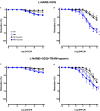Tocotrienol-Rich Tocomin Attenuates Oxidative Stress and Improves Endothelium-Dependent Relaxation in Aortae from Rats Fed a High-Fat Western Diet
- PMID: 27800483
- PMCID: PMC5065990
- DOI: 10.3389/fcvm.2016.00039
Tocotrienol-Rich Tocomin Attenuates Oxidative Stress and Improves Endothelium-Dependent Relaxation in Aortae from Rats Fed a High-Fat Western Diet
Abstract
We have previously reported that tocomin, a mixture high in tocotrienol content and also containing tocopherol, acutely preserves endothelial function in the presence of oxidative stress. In this study, we investigated whether tocomin treatment would preserve endothelial function in aortae isolated from rats fed a high-fat diet known to cause oxidative stress. Wistar hooded rats were fed a western diet (WD, 21% fat) or control rat chow (standard diet, 6% fat) for 12 weeks. Tocomin (40 mg/kg/day sc) or its vehicle (peanut oil) was administered for the last 4 weeks of the feeding regime. Aortae from WD rats showed an impairment of endothelium-dependent relaxation that was associated with an increased expression of the NADPH oxidase Nox2 subunit and an increase in the vascular generation of superoxide measured using L-012 chemiluminescence. The increase in vascular oxidative stress was accompanied by a decrease in basal NO release and impairment of the contribution of NO to ACh-induced relaxation. The impaired relaxation is likely contributed to by a decreased expression of eNOS, calmodulin, and phosphorylated Akt and an increase in caveolin. Tocotrienol rich tocomin, which prevented the diet-induced changes in vascular function, reduced vascular superoxide production and abolished the diet-induced changes in eNOS and other protein expression. Using selective inhibitors of nitric oxide synthase (NOS), soluble guanylate cyclase (sGC) and calcium-activated potassium (KCa) channels we demonstrated that tocomin increased NO-mediated relaxation, without affecting the contribution of endothelium-dependent hyperpolarization type relaxation to the endothelium-dependent relaxation. The beneficial actions of tocomin in this diet-induced model of obesity suggest that it may have potential to be used as a therapeutic agent to prevent vascular disease in obesity.
Keywords: endothelium; high-fat diet; oxidative stress; tocotrienol; vascular relaxation.
Figures






Similar articles
-
Tocomin Restores Endothelium-Dependent Relaxation in the Diabetic Rat Aorta by Increasing NO Bioavailability and Improving the Expression of eNOS.Front Physiol. 2019 Mar 4;10:186. doi: 10.3389/fphys.2019.00186. eCollection 2019. Front Physiol. 2019. PMID: 30886586 Free PMC article.
-
Tocotrienol Rich Palm Oil Extract Is More Effective Than Pure Tocotrienols at Improving Endothelium-Dependent Relaxation in the Presence of Oxidative Stress.Oxid Med Cell Longev. 2015;2015:150829. doi: 10.1155/2015/150829. Epub 2015 May 17. Oxid Med Cell Longev. 2015. PMID: 26075031 Free PMC article.
-
Epithelial sodium channels in endothelial cells mediate diet-induced endothelium stiffness and impaired vascular relaxation in obese female mice.Metabolism. 2019 Oct;99:57-66. doi: 10.1016/j.metabol.2019.153946. Epub 2019 Jul 11. Metabolism. 2019. PMID: 31302199 Free PMC article.
-
Diabetes Attenuates the Contribution of Endogenous Nitric Oxide but Not Nitroxyl to Endothelium Dependent Relaxation of Rat Carotid Arteries.Front Pharmacol. 2021 Jan 21;11:585740. doi: 10.3389/fphar.2020.585740. eCollection 2020. Front Pharmacol. 2021. PMID: 33716721 Free PMC article.
-
Decreased vascular H2S production is associated with vascular oxidative stress in rats fed a high-fat western diet.Naunyn Schmiedebergs Arch Pharmacol. 2016 Jul;389(7):783-90. doi: 10.1007/s00210-016-1244-4. Epub 2016 Apr 18. Naunyn Schmiedebergs Arch Pharmacol. 2016. PMID: 27087304
Cited by
-
Tocotrienol is a cardioprotective agent against ageing-associated cardiovascular disease and its associated morbidities.Nutr Metab (Lond). 2018 Jan 19;15:6. doi: 10.1186/s12986-018-0244-4. eCollection 2018. Nutr Metab (Lond). 2018. PMID: 29387138 Free PMC article. Review.
-
Promising Phytoconstituents in Diabetes-related Wounds: Mechanistic Insights and Implications.Curr Diabetes Rev. 2024;21(2):e270224227477. doi: 10.2174/0115733998279112240129074457. Curr Diabetes Rev. 2024. PMID: 38424430 Review.
-
The Role of Tocotrienol in Protecting Against Metabolic Diseases.Molecules. 2019 Mar 6;24(5):923. doi: 10.3390/molecules24050923. Molecules. 2019. PMID: 30845769 Free PMC article. Review.
-
Potential Role of Tocotrienols on Non-Communicable Diseases: A Review of Current Evidence.Nutrients. 2020 Jan 19;12(1):259. doi: 10.3390/nu12010259. Nutrients. 2020. PMID: 31963885 Free PMC article. Review.
-
Naringin ameliorates endothelial dysfunction in fructose-fed rats.Exp Ther Med. 2018 Mar;15(3):3140-3146. doi: 10.3892/etm.2018.5759. Epub 2018 Jan 17. Exp Ther Med. 2018. PMID: 29456717 Free PMC article.
References
LinkOut - more resources
Full Text Sources
Other Literature Sources
Miscellaneous

